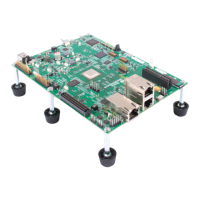TMS34010
C
Language
-
Identifiers,
Keywords,
and
Constants
4.1
Identifiers,
Keywords,
and
Constants
K&R
2.2
-Identifiers
• In
TMS34010
C,
the
first
31
characters
of
an
identifier
are
sig-
nificant
(in
K&R
C,
8 characters
are
significant). This also applies
to
external names.
• Case
is
significant;
uppercase characters
are
different from lowercase
characters in
all TMS3401 0 tools. This also applies
to
external names.
K&R
2.3
-
Keywords
TMS34010
C reserves
three
additional
keywords:
asm
void
enum
K&R
2.4.1
-Integer
Constants
• All integer constants
are
of
type int (signed,
32
bits
long)
unless they
have
an
L
or
U suffix.
If
the compiler encounters
an
invalid
digit
in
a
constant (such
as
an
8 or 9 in
an
octal constant),
it
issues a warning
message.
• You can append a letter suffix
to
an
integer constant
to
specify its type:
Use
U
as
a suffix
to
declare
an
unsigned integer constant.
Use L
as
a suffix to declare a long integer constant.
Combine the suffixes
to
declare
an
unsigned long integer constant.
Suffixes can
be
upper or lower
case.
• Here
are
some examples
of
integer constants:
1234;
/*
int
*/
OxFFFFFFFFui
/*
unsigned
int
*/
OLi
/*
lon9
int
*/
077613LU;
/*
uns~gned
long
int
*/
K&R
2.4.3
-
Character
Constants
In addition
to
the escape codes listed in
K&R,
the TMS3401 0 C compiler
re-
cognizes
the
escape
code
\v
in character and string constants
as
a vertical
tab character
(ASCII code
11
).
K&R
2.4.4
-
Floating-Point
Constants
4-2
TMS34010
C supports both single-precision and double-precision floating-
point
constants. You can append a letter suffix
to
a
floating-point
constant
to
specify its type.
• A
floating-point
constant that
is
used in
an
expression
is
normally
treated
as
a double-precision constant (type double).
If
you
want
to
use
a single-precision constant, use
F
as
a suffix
to
identify the constant
as
type float.
• ANSI standard C supports a long double type that can provide more
precision than a
double. Long doubles
are
specified
with
an
L suffix
(like long ints).
TMS34010
C does
not
directly support long doubles;

